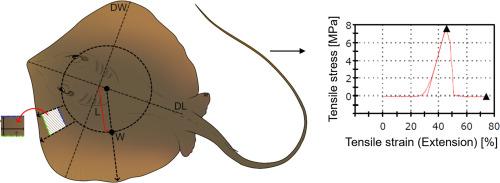蝙蝠皮的力学性能和形态在不同的功能游泳方式中有所不同。
IF 9.6
1区 医学
Q1 ENGINEERING, BIOMEDICAL
引用次数: 0
摘要
蝠状体是软骨鱼类,它们的身体形状是背腹压缩的,因此在各种游泳方式的有效调节应力方面受到独特的机械限制。先前的研究表明,一种蝙蝠类动物的皮肤具有各向异性,其力学行为在纵向(平行于脊柱)和环向轴(垂直于脊柱)之间变化。由于蝙蝠体游泳方式的多样性,机械行为的模式可能会有所不同。为了探讨运动策略对皮肤力学的影响,我们选择了6种运动类型:轴向波动(大西洋guitarfish Rhinobatos lentiginosus)、胸盘波动(大西洋黄貂鱼Hypanus sabinus、钝鼻黄貂鱼Hypanus say、牙买加黄貂鱼Urobatis jamaicensis)、半震荡(光滑蝴蝶鳐Gymnura microura)和震荡(牛鼻鳐Rhinoptera bonasus)。我们测试了背侧、腹侧和复合皮肤样本在准静态单轴张力下的失效,并量化了功能组、身体和椎间盘区域、性别和应力轴之间力学行为的可变性。我们假设蝙蝠体皮的力学行为(拉伸应变、强度、刚度、韧性)和形态会因游泳方式而异。虽然应变和刚度测量是近似的,但观察到的组之间的差异支持这样的结论,即波动器具有最可扩展的皮肤,而轴向波动器具有最坚固和最坚硬的皮肤。我们用大西洋黄貂鱼来评估机械行为的性别差异,我们发现雄性黄貂鱼的皮肤比雌性更结实。最后,我们讨论了可能影响机械性能的真皮小齿的含义。意义声明:本研究为理解不同游泳方式的蝙蝠类皮肤的力学特性提供了一个框架。之前的一项研究只调查了一个物种,对一个大型的、多样化的软骨鱼分支的皮肤力学提供了有限的见解。这里展示的结果包括来自六个物种的单个层和复合皮肤样本的数据,这些数据可用于设计机械专用的仿生和仿生材料。这些数据提供了蝙蝠体表皮肤力学的生物学范围,并为运动类型之间的机械行为的有效调节提供了见解。本文章由计算机程序翻译,如有差异,请以英文原文为准。

Batoid skin mechanical properties and morphology vary among functional swimming styles
Batoids are cartilaginous fishes that are dorsoventrally compressed in body shape and so experience unique mechanical limitations on the effective modulation of stress forces across various swimming styles. Previous research showed that the skin of one batoid species was anisotropic, where the mechanical behavior varied between longitudinal (parallel to the vertebral column) and hoop axes (perpendicular to the vertebral column). Due to the diversity of swimming modalities employed across batoids, the patterns of mechanical behavior may vary. To explore the effect of locomotor strategy on skin mechanics, we used six species to represent styles: axial undulation (Atlantic guitarfish Rhinobatos lentiginosus), pectoral disc undulation (Atlantic stingray Hypanus sabinus, bluntnose stingray Hypanus say, yellow stingray Urobatis jamaicensis), semi-oscillation (smooth butterfly ray Gymnura micrura), and oscillation (cownose ray Rhinoptera bonasus). We tested dorsal, ventral, and composite skin samples in quasi-static uniaxial tension to failure and quantified the variability in mechanical behaviors among functional groups, regions of the body and disc, and between sexes and stress axes. We hypothesized that mechanical behaviors (tensile strain, strength, stiffness, toughness) and morphology of batoid skin would vary among swimming styles. While strain and stiffness measurements are approximate, the observed differences between groups support the conclusion that undulators had the most extensible skin whereas axial-undulators had the strongest and stiffest skin. We assessed sex differences in mechanical behaviors using Atlantic stingrays, and we found male stingrays had stronger and tougher skin than females. Lastly, we discuss the implications of dermal denticles, which may affect mechanical properties.
Statement of significance
This study provides a framework for understanding the mechanical properties of batoid skin across groups of species that utilize different swimming styles. A previous study examined just a single species, offering limited insight into the skin mechanics of a large, diverse clade of cartilaginous fishes. The results presented here include data from individual layers and composite skin samples from six species, which can be used to design mechanically specialized biomimetic and bio-inspired materials. These data provide biological ranges for batoid skin mechanics and offer insight as to the effective modulation of mechanical behavior among locomotor styles.
求助全文
通过发布文献求助,成功后即可免费获取论文全文。
去求助
来源期刊

Acta Biomaterialia
工程技术-材料科学:生物材料
CiteScore
16.80
自引率
3.10%
发文量
776
审稿时长
30 days
期刊介绍:
Acta Biomaterialia is a monthly peer-reviewed scientific journal published by Elsevier. The journal was established in January 2005. The editor-in-chief is W.R. Wagner (University of Pittsburgh). The journal covers research in biomaterials science, including the interrelationship of biomaterial structure and function from macroscale to nanoscale. Topical coverage includes biomedical and biocompatible materials.
 求助内容:
求助内容: 应助结果提醒方式:
应助结果提醒方式:


